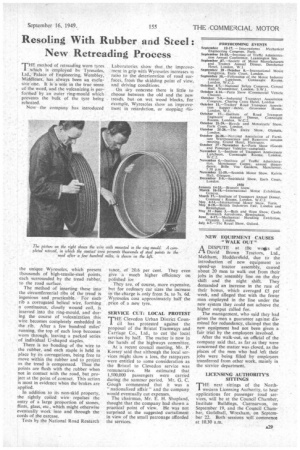Resoling With Rubber and Steel: New Retreading Process
Page 31

If you've noticed an error in this article please click here to report it so we can fix it.
THE method of retreading worn tyres which is employed by Tyresoles, Ltd., Palace of Engineering, Wembley, Middlesex, has always been an exclusive one. It is a sole in the true Sense of the word, and the vulcanizing is performed by an outer ring-mould which prevents the bulk of the tyre being reheated.
Now the company has introduced the unique Wyresoles, which present thousands of high-tensile-steel points, each surrounded by the tread rubber, to the road surface.
The method 'of inserting these into the circumferential ribs a the tread is ingenious and practicable. For each rib a corrugated_ helical wire, forming a continuous, closely wound coil, is inserted into the ring-mould, and during the course of vulcanization this wire becomes completely embedded in the rib. After a few hundred miles' running, the top of each loop becomes worn through, leaving a packed series of individual U-shaped staples.
There is no bonding of the wire to the rubber, and each staple is held in place by its corrugations, being free to move within the rubber and to project as the tread is compressed. Thus the points are flush with the rubber when not in contact with the road, but project at the point of contact. This action is most in evidence when the brakes are applied.
In addition to its non-skid property, the tightly coiled wire repulses the entry of a large proportion of stones, flints, glass, etc„ which might otherwise eventually work into and through the cords of the carcase.
Tests by the National Road Research Laboratories show that. the improve: mein in grip with Wyresoles increases in ratio to the deterioration of road surfaces, from 'the skidding point of view, and driving conditions.
On dry concrete there is little to choose between the old and the new treads, but. on wet, wood blocks, for example, Wyresoles show an improvement in retardation, or stopping rlis ranee, of 20.6 per cent They even give a much higher efficiency on polished ice They are, of course, more expensive, but for ordinary car sizes the increase
the charge is only from 5s. to 75. 6d. Wyresoles cost approximately half the price of a new. tyre.
SERVICE CUT: LOCAL PROTEST
THE Clevedon Urban District Coun
cil has protested against the proposal of the Bristol Tramways and Carriage Co., Ltd., to cut the local services by half. The matter is now in the hands of the highways committee.
At a recent council meeting, Mr. P. Keesey said that although the local services might show a loss, the ratepayers were entitled to some consideration as the Bristol to Cleyedon service was remunerative. He estimated that 1,500,000 passengers were carried during the summer period. Mr. G. C. Gough commented that it was a nationalized affair" and the company would eventually cut expenses.
The chairman, Mr. E. H. Shopland, thought that the company had shown a practical point of view. He was not surprised at the suggested curtailment in view of the small patronage afforded the services.




















































































